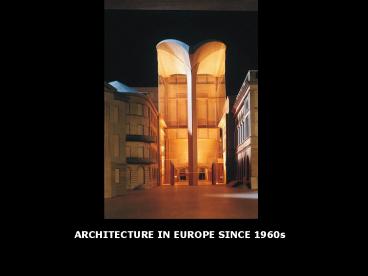ARCHITECTURE IN EUROPE SINCE 1960s - PowerPoint PPT Presentation
1 / 29
Title:
ARCHITECTURE IN EUROPE SINCE 1960s
Description:
'If, with the opening of the Seagram Building in 1957, western architecture once ... colorful, decorative, sometimes whimsical buildings mark a return to historicism. ... – PowerPoint PPT presentation
Number of Views:468
Avg rating:3.0/5.0
Title: ARCHITECTURE IN EUROPE SINCE 1960s
1
ARCHITECTURE IN EUROPE SINCE 1960s
2
(No Transcript)
3
The Cost of Modernism. If, with the opening of
the Seagram Building in 1957, western
architecture once again achieved an international
unity that had eluded it for two hundred years,
that unity was short-lived. Critics could not
long ignore the fact that this unity was achieved
at a cost of the honesty of materials Mies and
Wright had earlier championed. It was achieved
only with other sacrifices, too. One was the
sacrifice of the city the great modern towers
abandoned the city as much as their medieval
prototype towers withdrew and dominated the
Italian hill-towns. A second was the sacrifice of
personal or local character these office towers
were so classical and elegant that they could be
copied--not with the same creativity, to be
sure--in the cookie-cutter rows that so deadened
western cities. The third was the sacrifice of
history modern architecture believed for a good
while that it had no past, only a future.
4
The Reactions to Modernism Le Corbusier
bridged the gap between abstract and expressive
architecture, as well as between the tectonic and
sculptural approach to building. Mies van der
Rohe never wavered from his early design
formulations, but other "early modern" architects
did. Wright's last works were strange and highly
personalized visions of history (Guggenheim
Museum, Marin County Civic Center). Le
Corbusier's chapel at Ronchamp went against a
score of his early positions, and admitted
history, representation, and eccentric use of
materials where they had formerly been banished.
Eero Saarinen's TWA terminal at JFK Airport
caused Americans in particular to ask if there
were not some alternatives to "classical"
modernism. Finally, Robert Venturi's book
Complexity and Contradiction in Architecture,
published in 1966, argued that the American city
had a logic and a strength that should be frankly
incorporated in contemporary style, rather than
papered over. Venturi saw architectural history
as far more quirky and eccentric than the
"classic" and progressive view that had formerly
been propagated. This opened the floodgates to
new departures in architectural design, embracing
history, populism, anthropomorphism, and
vernacular design. The result -- the contemporary
expression in architecture -- has been known
since the mid 1970s as Post-Modern.
Post-Modernism is effectively a pluralistic
approach in which colorful, decorative, sometimes
whimsical buildings mark a return to
historicism.
5
Postmodernism.
Postmodernism designates a multitude of
trendsin the arts, philosophy, religion,
technology, and many other areasthat come after
and deviate from the many 20th-cent. movements
that constituted modernism. Widely debated with
regard to its meaning and implications,
postmodernism has also been said to relate to the
culture of capitalism as it has developed since
the 1960s. In general, the postmodern view is
accepting of the fragmentation of contemporary
existence. Postmodern architecture, in
distinction to the view of Modernism as orthodox,
austere and formally absolute, is characterized
by the incorporation of historical details in a
hybrid rather than a pure style, by the use of
decorative elements, by a more personal and
exaggerated style, and by references to popular
modes of building. Practitioners of postmodern
architecture emphasizes elements of metaphor,
symbol, and content in their thinking and their
work. They share an interest in mass, surface
colors, and textures and frequently use
unorthodox building materials. Any of several
artistic movements since about the 1960s that
have challenged the philosophy and practices of
modern arts or literature. In literature this has
amounted to a reaction against an ordered view of
the world and therefore against fixed ideas about
the form and meaning of texts. In its reaction
against Modernist ideals, postmodern writing and
art emphasize devices such as pastiche and parody
and the stylized technique of the antinovel and
magic realism.
6
History Faculty Building, Cambridge Engineering
Faculty Building, Leicester
JAMES STIRLING
7
Staatsgalerie, Stuttgart, Germany
8
(No Transcript)
9
LEON KRIER
10
(No Transcript)
11
(No Transcript)
12
Auskrust Museum, Aldval, Norway
SVERRE FEHN (NORWAY)
13
Glacier Museum, Fjaerland, Norway
14
Cathedral Museum
15
Royal Theater, Copenhagen
16
(No Transcript)
17
ALVARO SIZA (PORTUGAL)
18
Church of the Pilgrimage, Neviges, Germany Church
and Youth Center, Cologne
GOTTFRIED BOHM (GERMANY)
19
Schullin Jewelry Shop, Vienna
Retti Candle Shop, Vienna
HANS HOLLEIN (AUSTRIA)
20
Haas House, Vienna
Museum of Modern Art, Frankfurt
21
Museum at Monchengladbach
22
Paul Klee Center, Bern
RENZO PIANO (ITALY)
23
Cultural Center, Tjibao, New Caledonia
24
Law Courts, Bourdeaux, France Science Center,
Amsterdam
25
Norman Foster, Contemporary Art Museum, Nimes,
France
26
REM KOOLHAAS (HOLLAND)
27
House in Bourdeaux, France Prada Store, New York
City
28
Seattle Public Library Television Tower, Beijing
29
Plan for Les Halles, Paris































